How do you successfully transition from a freemium model to serving enterprise clients? For Karl Sun, CEO of Lucid Chart, and Dan Cook, VP Sales of Lucid Chart, they had to build an extremely successful freemium business (with 10 million users!) first as it provided the foundation for the shift to selling to the enterprise.
Karl and Dan discuss why they chose a freemium model, how they got to 10 million users, and the different evolutions the company experienced as they moved into enterprise sales.
The first evolution was migrating from support to sales. The second was evolving from a digital marketing focus to one that was demand or lead gen. The third was an evolution from end user support to a customer success organization. The fourth was going from an end user product focus to an enterprise product focus.
If you want to know more about Lucid Chart’s incredible journey, don’t miss this talk!
You can view the slide deck here.
And if you haven’t heard: SaaStr Annual will be back in 2018, bigger and better than ever! Join 10,000 fellow founders, investors and execs for 3 days of unparalleled networking and epic learnings from SaaS legends like Jon Miller, David Steinberg, Jennifer Tejada, and Eoghan McCabe. If you don’t have tickets, lock in Early Bird pricing today and bring your team from just $999! (All ticket prices go up December 31st.) Get tickets here.
TRANSCRIPT
Announcer: 10 million freemium users can’t be wrong. Please welcome Lucid Chart CEO and VP of Sales, Karl Sun and Dan Cook.
Karl Sun: Welcome everyone. Thanks for being here. We’re from Lucid Software. We’re excited to tell you about our journey, which is an ongoing journey from a freemium-only business that now has over 10 million users towards more of an enterprise focus.
Let’s see. Are our slides working?
Dan Cook: I guess that’s the last one there. We’re done.
Karl: We’re done. All right. That was quick. Sorry.
Dan: Close your eyes.
Karl: Before that, just a few quick introductions. My name is Karl Sun. I am the CEO and one of the co founders at Lucid Software. I actually started my career here in the Bay Area as a lawyer, had the chance to join Google as one of the first in-house lawyers, and then switched over to business development and had a chance to start the China office actually and ran business development there for a while.
When I moved back to the US, I actually ended up in Utah, in part because my wife took a teaching job there, in part because of the excellent skiing. It was there that I met my co-founder and started Lucid.
Dan: Hey, guys. My name is Dan Cook, a New Hampshire native. Started my career actually here in San Francisco in investment banking, then moved to Boston where I worked in venture capital, then in business school, and joined Lucid about three years ago where I run our sales and business development efforts.
I did sneak this slide in. Karl didn’t know this was coming. This is him in the original Lucidchart basement apartment where the company was founded. There is a session after that we’ll give a shout out to, talking about the relationship between VPs of Sales and CEOs, so I wanted to take a moment to troll Karl. You looked a lot younger and a lot thinner back then.
Karl: Thanks, Dan, I think.
[laughter]
Karl: I think that next talk actually talks about the changing relationship between VPs of Sales and CEOs, so we can talk about that in your performance review.
[laughter]
Dan: Yeah, I’m screwed.
Karl: For those of you who aren’t familiar with Lucid, our core product, Lucidchart lets you express your ideas visually. Users use Lucidchart to document and communicate systems and processes using flowcharts, mind maps, and all sorts of other types of diagrams. Lucidchart basically lets you communicate complex ideas in a quick and efficient way.
Our users actually come from all sorts of job functions. A lot of them are in the IT and engineering space, so those users might use Lucidchart to create network diagrams, or map out database schemas.
There are business process analysts who use Lucidchart to visualize different kinds of processes, and then you’ve got product managers and project managers who might use Lucidchart to create wireframes, or to design software workflows.
Dan: Yeah, it’s interesting too. On the sales side, we’ll use Lucidchart to map out process that we’ll then train our reps on, so from a sales ops and enablement perspective, it’s pretty helpful.
We’ve seen some sales reps use it in more of their sophisticated sales where they’ll map out a prospect’s process and then say, “Hey, if you implement our solution, here’s what it would look like afterwards.” A wide, vast way that Lucidchart can be used.
The product actually has 10 million plus users. Over 80 percent of the Fortune 1,000 have at least one Lucidchart user. I bet if we polled the audience and the companies that you all have founded, there’s probably a few folks that are using Lucidchart in some way, shape, or form.
This is just a list of some of the great SaaS and tech companies that we’re able to show you that are using Lucidchart at some level of scale.
Karl: Great. As I mentioned, I met my co founder and started Lucid in Utah, and actually that’s where we still are today. We’re proud and excited to be part of the growing and thriving tech and SaaS ecosystem out in Utah, called Silicon Slopes.
Utah’s actually a pretty fantastic place to be in terms of quality of life, and I really don’t think there’s anywhere else you can ski 15,000 vertical feet and then be in the office before noon.
Dan: So we’re hiring.
Karl: That’s right, good plug. Before we talk about the transition to the enterprise focus, I thought it made sense to tell you a little bit about why we chose freemium and then the things that have made us successful on the freemium side. Those have actually been the foundation for this shift and it’s been a very natural evolution to focus more on the enterprise.
Here’s the timeline. As you all know, the freemium model has been around for a long time now. Here’s just an image with some of the great products and businesses that started in a freemium only format.
I suppose when we started Lucid in 2010, it was natural that we chose freemium, in part because there are all these other great companies that we could model ourselves on.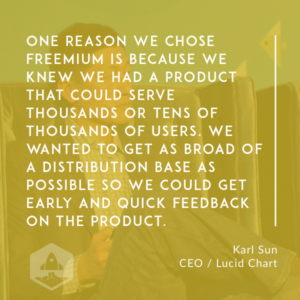
A second reason that we chose freemium, though, is because we knew we had a product that could serve thousands or tens of thousands of users. We really wanted to get as broad of a distribution base as possible so we could get that early and quick feedback on what the product was doing well and what we needed to improve.
Thirdly, and somewhat relatedly, the freemium model really allowed us to focus a vast majority of our resources and effort, and by that I mean time and money, on the product. Hiring engineers and product managers to really build out the product.
It turns out that if you put the free product out there and then add some pay walls, it’s actually a relatively easy way to start monetizing a product. Obviously, you have to optimize that process along the way.
Along the way, we did, in our freemium days, manage to figure out a few core competencies that allowed us to get some early traction and a little bit of early success in the freemium world.
I want to tell you a little bit about that. On the marketing side, we built a lean and mean, digital marketing team. By digital marketing, I mean focus a lot on SEO, layered on with a little bit of SEM over time.
That team was really focused on very effective and efficient user acquisition, then using data science and a lot of analysts and running a lot of experiments, trying to optimize that funnel so that those users that were acquired would slowly convert, or quickly convert into paying customers.
We also built just a tremendous support team that was awesome at getting back to our users quickly and with thorough answers, so that even when our users ran into bugs or problems with our product, they were getting a great experience. I can’t stress enough how having a great team like that can build goodwill amongst the user base.
Finally, and maybe most importantly, having a great product and an engineering organization that was constantly working to improve that product and make it really intuitive and easy to use, but at the same time, very powerful so that it was adding value and making our users’ work lives better each and every day.
That obviously didn’t happen overnight, so it took a little while for us to figure that out. In fact, it took several years for us to get the product to a state where we thought it was where we want it to be. It took even a little bit longer to build that conversion funnel into a shape that we thought was successful and scalable.
It really wasn’t until 2013 or 2014 when we started to think about how far the freemium model could take us on its own. It was about that time that, there were other companies such as Box, for example, that were showing that you could start freemium but then build a really successful enterprise business.
It was also around that time that people in the industry, like Jason here, were talking about the freemium model and saying quotes like this. He started by saying, “We’d all love to do freemium because we don’t have to hire salespeople.” I have to admit that was very much my mentality when I started the company.
After all, I grew up at Google, and I think there was this belief that if you build a great product, people will come and somehow they’ll just decide to pay you and life will be good. Of course, what Jason went on to say to finish that quote is that we all figured out that there’s not enough businesses to build $100 million business on freemium alone.
This really presented a conundrum for me and for our team because, quite frankly, I’m not a sales guy. I didn’t grow up in that world. I don’t understand sales, or I didn’t at the time. I didn’t know how to hire salespeople.
I didn’t know how to think about what the sales process should be, or how to think about how efficient it was. Obviously, I was concerned that layering on the sales team would add cost and concerned about what that would do to our business model and our unit economics.
For those of you who were here at SaaStr last year, you may have seen David Skok’s presentation on driving successful SaaS businesses using key metrics. Actually, I think he presented earlier this afternoon as well.
He described how as you move from a freemium model to a non touch, self service and then a light touch, inside sales and as you continue down this food chain, how the costs obviously increase. Your customer acquisition costs increase, but they don’t increase linearly. They increase in an exponential format.
The challenge then would be if we want to do sales, we know we’re going to add cost. Obviously, we need to figure out how much cost that would add. On the backend, you need to find a way to derive more value from those customers. You need to drive up that LTV to balance, to offset that increase in CAC, and hopefully, to exceed that increase in CAC so that you can have a more successful business going forward.
It was around this time that we figured we really should try to figure out whether sales was a viable path, and if so, how that would work. That’s when we brought Dan on board. I’ll turn the time over to him to talk about some of the experiments and learnings that he gave us.
Dan: I was really thrilled, obviously, to join Lucid. Having spent some time at a VC firm where you evaluated businesses all day long, it wasn’t every day that you saw 100 percent growth year over year, profitability, and no sales organization whatsoever. This was a great opportunity.
Karl brought me in in an operations role, which was his way of saying, “I don’t really know what to do with you.” The first operation was to build some dashboards. I dusted off PowerPoint and made some crappy dashboards.
I must’ve sucked because then the next one was, “Hey, what would a sales team look like?” which was a much different ask. We spent some time thinking about, “What would a sales organization look like? What would sales process look like at Lucid?”
At the same time, there were a variety of other initiatives or evolutions occurring that really set us up as we pondered and considered how we’d move into the enterprise. We’re going to talk over the rest of the presentation about some of these that we’ve highlighted here in this slide.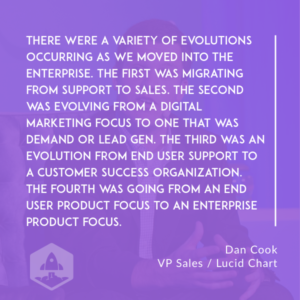
The first was an evolving support organization that actually helped facilitate our move into building a sales organization. The second was evolving from a digital marketing focus only, focus on the funnel that Karl spoke of, to one that actually generated leads for sales reps to follow up with.
The third was an evolution from end user support to actual enterprise admin support via a customer success organization. The fourth was more product related. Everything in a freemium model focused on end user product experience. How do we evolve to build features that enterprise admins and enterprise buyers need to have in the product?
We’ll talk about a couple of those. The first was this migration from support to sales. We wouldn’t be doing our job if we didn’t put a flowchart in at least one slide of our presentation. This was designed in Lucidchart.
This simple process was actually how our support team was engaging with tickets that came in that had sales interest. Imagine someone sending a ticket says, “I want to buy more Lucidchart.” Our support team would send them an email that said, “Hey, here’s how you buy our product,” and then a week later would follow up to see if they bought.
They’d do that for two or three weeks. If they never bought, they would solve the ticket and move onto the next one. This is what they were paid to do, solve tickets.
It didn’t take a sales guru to realize that there was some opportunity here. We read the Aaron Ross books. We read all the InsideSales.com white papers, five minutes or less respond to these leads. I became the sales rep, responded as quickly as possible to these inbound support tickets, and found that we were able to move the needle from an incremental ARR standpoint.
Now, that’s obviously a no brainer, but there were some other interesting things that we discovered. Our COO spent a month and a half reading every single support ticket and actually categorizing them based on some level of sales interest or intent. We thought we’d share a couple of them with you that may or may not have relevance to you all.
One of them was really interesting. We found that anyone that submitted a support ticket from a customer or prospect where there were already a lot of freemium users, we would have our support team answer their question, and then CC or introduce a sales rep, who would say, “Hey, hope you got your question answered. Would you be willing to introduce us to your admin or IT buyer at your organization?”
Because our support team did such a good job, we would get great referrals into enterprise buyers that would allow us to have these great sales conversations.
A second one was anyone who asked about our integrations, Lucidchart plugs into Google Suite and plugs into Slack. If anyone put in a support ticket asking about it, we would have a sales rep engage. We realized that many times they represented interesting companies, they wanted to buy more.
A third one was if they asked for trial extensions, and a fourth one was anytime there were admin changes. You can see from this Lucidchart diagram, the process got a little more complex.
Over a period of time, we showed that we were able to generate hundreds of thousands of dollars of incremental ARR from engaging with our support tickets. This really was an evolution for us into having a sales model.
I guess the summary or takeaway that I would suggest on this one is, when was the last time–and that’s not an intern or a support rep–when is the last time you as a CEO or VP of sales spent time in the support channel because there’s a ton of gold in there. We found that to be true for us.
The second evolution we wanted to walk through was this idea of going from a digital marketing focus to one that was more demand or lead gen. We came up with a hypothesis that there were certain folks that actually didn’t want to jump into the product. They wanted to talk to us.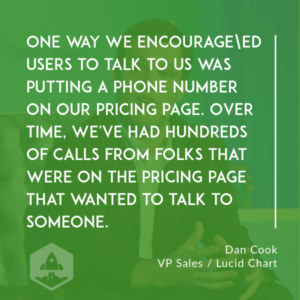
We came up with three ways that we encouraged users to talk to us. Now, again, some of these weren’t rocket science, but the first, believe it or not, was to put a phone number on our pricing page. We picked a 650 area code because that’s the Bay Area. We thought that would make us sexier.
[laughter]
Dan: It was hilarious. We hooked up on an old iPhone to it. I called it the “bat phone” and we had it on my desk. The first time the phone rang, the whole office was staring at me. I’m really pumped because I’m thinking it’s eBay about to buy 10,000 licenses. I get on the phone, and the guy says, “Yeah, I’d like to cancel my account.”
[laughter]
Dan: Needless to say, I hang it up and everyone’s looking at what happened. I was like, “They hung up.”
Anyway, over time, we’ve had hundreds of calls from folks that were on the pricing page that wanted to talk to someone. We used the phone numbers. We put them in a lot of our collateral and emails to drive those types of conversations.
A second one, which is a no brainer, is you put up lead forms. You’ll see that here. We have an enterprise skew, but you got to talk to a rep. We were again trying to facilitate conversations with our sales team.
The last one was around emails, using marketing automation to really find trigger points where if someone was visiting certain pages on our site, that we would trigger an email from a rep. If the person responded to the email, our reps would engage.
The takeaway for this one for us was, “What are you doing to find ways to communicate with your customers? What are you doing to find ways for them to communicate more with you?”
The freemium model sometimes has a tendency to make you introverted because you’re really optimizing for a funnel. We found that by engaging and talking to these folks, especially when they raise their hand, we were able to drive bigger deals.
Karl: It’s interesting to note here, one conversation that we had is we had these sales reps, the early reps that were the closing deals. They were pumped. Everyone was excited, but we knew that some of those deals would’ve closed, and they would’ve paid us through our self serve channel anyways.
There was some conversations about, “Well, how much incremental value are they really adding? Are we paying them the right amount?” The bottom line is you have do your analysis, which we did. It became clear to us that having a customer rep engage with the customer and having someone live there to talk to them really did drive up incremental value in ARR.
Even beyond that, you can’t sweat it. You have to model out the deals that you think would close anyways that might cannibalize a little bit your self serve, but then you build that into the quota appropriately.
If you’re going to hire sales reps, you’ve got to pay them. They’re hungry. That’s what they’re paid to do. Yes, they are going to close some deals that might have closed anyways, but that’s part of life.
Dan: It’s something we continue to iterate on and figure out. The third evolution that we thought we’d run through was one of this idea of supporting end users via a support team to a customer success driven organization.
As you might suggest, or as you might understand, with the freemium model, you have all these users. They need help and support. Our support team would handle them.
As we started to have more and more conversations with these great companies and enterprises, the type of support that they required changed as well. They wanted to talk to someone at any given time when they had questions. They wanted technical support on the spot.
We built a customer success organization that was really tailored around providing what I’ll call admin level support. There was a couple of things that we developed as a result, that we thought we’d share.
The first was something coined by our VP of Customer Success, was the process of being approved and enabled. Inevitably, if you want to deal with these larger companies, you’ll find that they’re going to ask for security reviews and audits. They’re going to want to do legal custom terms and conditions.
We decided to play the game and do the dance. By going through that process, you do get approved at these businesses to the point where in many instances, it lowers the bar for further adoption of your app.
It requires upfront resources. Fortunately, Karl’s a lawyer, so he could do all the custom terms and services, which he hated, by the way. We were able to sign a lot of these great deals, and that’s only one part of it.
We have here a variety of integrations that our app plugs into. As a part of the move to our enterprise SKU, we would have our CSM get on the phone and help integrate Lucidchart into Google Suite, into Confluence and JIRA, into Slack and these other apps, and it was really interesting to see what happened. We call this the enablement process, or enabled.
We found that the end users were happier because they could use Lucidchart in a variety of other places. We also found that Lucidchart adoption grew even further because we were plugged into other apps and discovery became a little easier. This was actually a great find for us that CS was not only able to be there to answer questions, but actually facilitated future growth and a higher LTV.
Karl: It’s an important point there because I talked earlier about this challenge as you increase your acquisition cost, how do you increase the lifetime value of that customer. I think the combination of customer success with sales really allowed us to do that.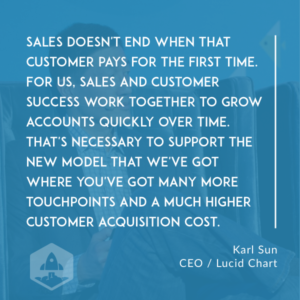
Sales doesn’t end when that customer pays for the first time. In fact, for us now, sales and customer success work together once those accounts come in to grow them quickly over time. That’s quite frankly necessary to support the new model that we’ve got, where you’ve got many more touchpoints and a much higher customer acquisition cost.
We’re going to go through an example towards the end just to give you a case study of one example of an enterprise customer of ours that has grown significantly since coming on board.
Dan: The last evolution that we just thought we’d talk through and then we’ll be done here. From a product standpoint, if you think about it, when you’re freemium only, everything you’re doing from a product road map is to make the end user experience a great one.
Fortunately for us, we had a great engineering team, a great product team that did that, that really got a lot of people into the product. As we had more and more of these sophisticated conversations, it’s just a fact that these enterprise guys want and require certain features that maybe have no impact on the end user experience, but that they have to have in order to bless you as being a vendor at their company.
Over a period of months, in fact years, we’ve gotten feedback from some of these large enterprises on stuff they just had to have, and it required a pretty savvy product organization to understand what was required and what were just nice to haves from some of these enterprise buyers. Obviously, you start to see some themes.
The result is that we actually have built certain features. For example, this is a screenshot of an admin panel where any of the admins of Lucidchart could see who the different users were and what apps we were integrated with, etc. We actually built those features because it facilitated these enterprise conversations and also just made them happier, quite frankly.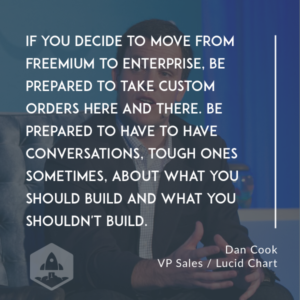
I think the takeaway here is if you decide and if you’re a part of this move from freemium to enterprise, be prepared to take custom orders here and there. Be prepared to have to have conversations, tough ones sometimes, about what you should build and what you shouldn’t build.
We’ve had to do that. We now have an enterprise product team with engineers who are constantly looking for ways to iterate and improve the product from an enterprise standpoint.
That’s the four evolutions that we thought we’d walk through with you here today. Each of them I think is a unique one that took this base that we built as a freemium only business and evolved to help both serve and sell and provide products to some of these great enterprises.
Karl: Just to give you a sense, this last slide is one example of an enterprise customer of ours, a very successful one for us, and the history and journey of this customer over time as a Lucidchart user and then customer. As you can see, Patient Zero, as we call this person, probably started in 2010 some time, registered probably as a free user.
We had some minimal, slow adoption over time. I’ll let Dan talk about how each of those four steps that we talked about came into play here and was pretty key in helping us to grow this account slowly over time, but at an accelerating rate.
Dan: That’s right. You can see here. We had an IT buyer reach out to us via one of the forms in 2014. They said, “Hey, we want to talk to somebody about buying more Lucidchart.” We got on the phone with them. We had a sales team now at this point. As you might suspect, they had all kinds of asks and requests from a product standpoint.
You can see here our move to being demand gen helped, our move to having enterprise product capabilities helped, we were able to close an enterprise deal.
Because we got the account enabled, the way that we explained to you, growth skyrockets as a result, and CS is there to facilitate that post sale expansion. Even when it comes to renewal, we find that that’s a new capability that we’re continuing to hone in on, is how do you then use the renewal to drive additional growth and revenue from the prospect?
That’s really all we had today. We hope this was helpful. We’ve learned a lot. I think we are in the middle of this. We’ve seen some great companies here today that have gotten there and are doing it.
If there’s anything or any ideas that you all have, we’d love to connect, whether it’s LinkedIn or elsewhere, we’d love to chat about best practices and that sort of thing.
Karl: Thanks very much for you time.
Dan: Thank you.

